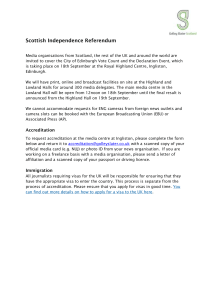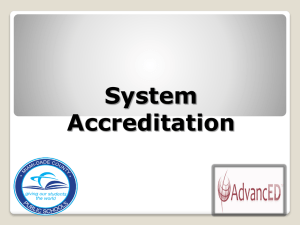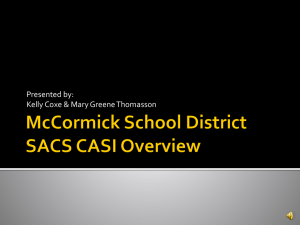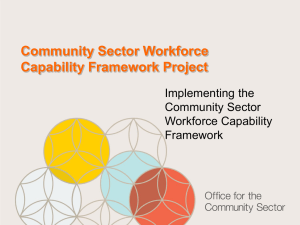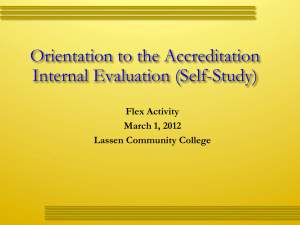Advice-Centre-Network-Meetings-Standard-1
advertisement
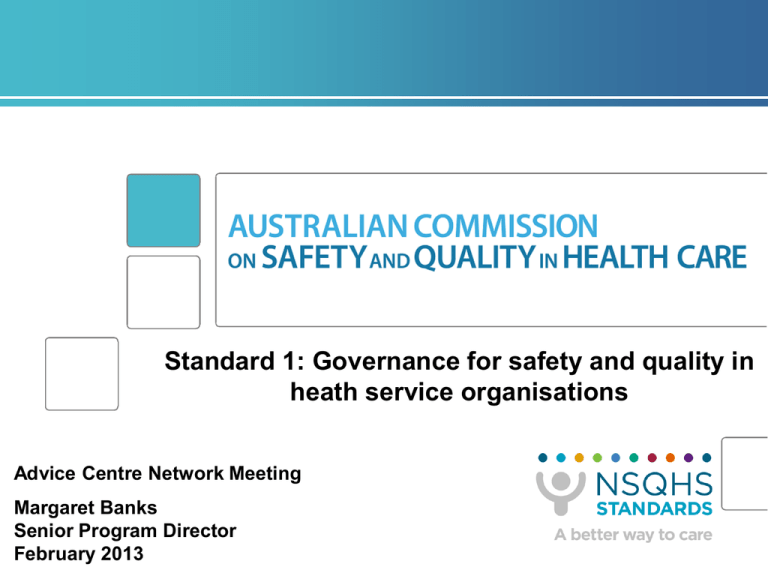
Standard 1: Governance for safety and quality in heath service organisations Advice Centre Network Meeting Margaret Banks Senior Program Director February 2013 Standard 1 • Overarching standard, setting the framework to implement the clinical standards 3 to 10 • Assessed at every accreditation event • Not achievable without engagement at all levels of the organisation Standard 1 - Governance for Safety and Quality Focus is on systems • Setting up policies and processes • Clarifying accountability and responsibility • Providing a structure for good clinical practice • Determining reporting and monitoring • Specifying workforce requirements • Setting the framework for ensuring patients rights Risk Assessment Standard 1.5 requires an organisation-wide risk management system Risk management approach Risk management is the design and implement of activities to identify and avoid or minimise risks to patients, employees, visitors and the institution. To manage their safety and quality risks, health services will need to – demonstrate they have undertaken a comprehensive risk analysis – collect data that provide information about the risks and trends over time – prioritise risks across an the health service – implement strategies that focus on areas of greatest risk – consider wards/facilities specific risk and put in place strategies that are appropriate Workforce Training 1.4.4 requires Competency-based training is provided to the clinical workforce to improve safety and quality Not intended that health services apply resources to training competent staff Health services need to be able to: • Articulate the competencies required • Identify the areas posing the greatest risk to patients when the workforce is not appropriately skilled • Determine how competencies will be assessed • Assess the workforce and identify those that require training • Schedule training only for members of the workforce that require additional or higher levels of competencies Data and Monitoring 1.6 requires organisation monitoring and reporting, that is the basis for monitoring and reporting throughout the rest of the Standards: eg 3.2 Surveillance of healthcare associated infections 4.10.3 Monitoring of temperature-sensitive medicines 7.8.1 Monitoring blood wastage This information is key to: • Measuring and managing risks • Change management • Information for decision making • Identify areas for improvement • Driving and evaluating continuous quality improvement • Providing evidence for accreditation Questions • Is it a requirement to have the Standards as part of staff and performance appraisals? The Standards shouldn’t be part of the conversation, safety and quality should be. This may include their understanding of their role, issues they have identified, training requirements, involvement in safety and quality activities. • We use a Framework for Quality and Patient Care that covers Action 1.1, do we need to badge this as a policy? No, the name is immaterial, so long as it is clear to staff this is the basis for setting rules and expectations and directing bahaviour Questions • Is 1.3 just about WHS? 1.3 is about clarifying what each person is responsible for and how they are held accountable for this for safety and quality generally in the organisation and specifically for them. It is broader than workplace health and safety and should address each of the issues covered by these Standards and any other safety risks identified for their organisation. • Does my board, with extensive skill and experience in governance need further training to meet the requirements of these Standards? No, they may not, but they will need to be informed about the intent of the Standards, they may advice on reading, interpreting and knowing what safety and quality information to ask for to make informed decisions on behalf of the organisation. Questions • Does 1.10 requires peer review processes be put in place for nurses? Peer review is one mechanism to determine if a clinician is working within their scope of practice. For nursing, you could position descriptions, orientation to the service unit whenever a clinician takes up a new role, supervision, procedures that specify the level or type of clinician to perform a task/function. • How do we put in place 1.10.1 for VMOs? Defining the scope of practices for VMOs is done through a credentialling process, which considers the VMOs skills, the requirements and capabilities of the organisation and the service to be provided. Once defined the VMO should be informed/trained to perform this role and any restrictions on the role. Processes need to be in place so the VMO practices only within the agreed scope of practice. Questions • The Standards require routine / regular review, how often is that? How often a item is monitored, audited or reviewed is dependent on the risk of harm and the service context. The simpler the service the less frequent the review. Where there a greater risk of patient harm, reviews will occur more often. Harm can result because something is inherently risky, or because it occurs frequently so the chance of harm occurring is greater, or is an infrequent events that cause catastrophic so requires frequent review so harm can be avoided. • What training is mandatory and how do we provide competency based training? The Standards mandate training of Aseptic Technique and Basic Live Support, and this is only provided where there are skills gaps identified following an assessment. Other training provided in safety and quality should be determined by the organisations safety and quality needs. What does this mean for Accreditation? No longer possible to achieve accreditation if: • The organisations relies on ‘events management’ • The Quality Manager is responsible for the organisation achieving accreditation The new requirements mean that: • Standards are no longer assessed ‘on balance’ and • Health services must provide evidence that each action is met Again – it is not possible to meet accreditation requirements without the participation of the whole organisation Providing evidence for accreditation • Quality improvement processes generate documentation • Evidence for accreditation should come from the normal business of providing care and driving improvement • Accreditation should not be a ‘Paper War’ • Accreditation Workbooks provide a checklist only
